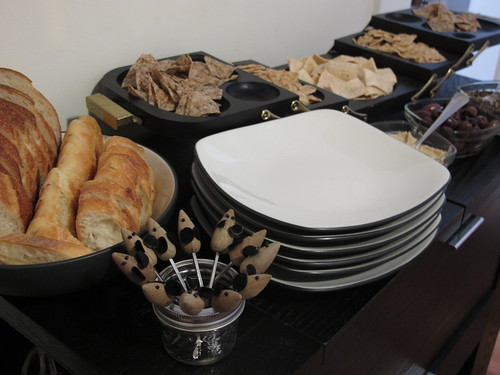For SpriteKat's party we inadvertently picked two things that were of little interest to her, cheese and antipasto. (She'd already investigated and played with the mice, even misplacing the cute vintage wind up toys somewhere in our apartment.) Typically when food is out and guests are around, SpriteKat is begging for nibbles.
After months of sampling and comparing various deli meats and cheeses we arrived at our spread (modified slightly due to the craziness Rainbow Grocery's Customer Appreciation Day brought to their cheese counter).
| A Sampling of Cheeses from Bi-Rite |
- Petit Basque
Pasteurized Sheep’s milk, created in 1997 by the French dairy giant Lactalis, produced in the Pyrenees Mountains of France from December to July.
Firm, washed rind cheese with mild, nutty and slightly sweet fruity flavor with caramel notes. Pairs nicely with sliced apples and pears or stone fruits such as peaches, apricots or cherries. Can also be served with olives and pate. - Idiazabal (pronounced Eee-dee-ya-ZA-bal)
Unpasteurized Sheep’s milk from a village located in Goierri Valley, Basque region of Spain.
Semi-soft pressed cheese, sometimes smoked over beechwood, hawthorn or cherry, with a rich nutty, buttery flavor. Often eaten with quince jam. - Arte Queso Manchego
Pasteurized Sheep’s milk produced in the La Mancha region of Spain.
Semi-firm pressed cheese aged for 4 to 12 months with well developed, but not too strong buttery flavor, nutty piquancy, and peppery body. In antipasto plates, serve with olives, sun-dried tomatoes, crusty bread, and robust red wine or dry Sherry. - Garrotxa (pronounced gah-ROH-chuh)
Unpasteurized Goat’s milk made in Girona, a north-central Catalonia province in Spain.
Semi-firm pressed cheese with mildly herbal and tangy flavor with hints of hazelnuts in the aftertaste as well as white pepper. - Gouda – a comparison
(on the left in the photo above) Semi-firm cheese from pasteurized Goat’s milk, aged for 2 to 4 months, with mild nutty flavor and peppery aftertaste.
(on the right in the photo above) Ewephoria, Semi-firm cheese from pasteurized Sheep’s milk, aged for 10 months, with sweet, nutty, buttery flavor. - Fiore Sardo
Raw Sheep’s milk from Sardinia, the island north of Sicily, off the Italian Coast.
Firm cheese that’s sharp and savory with wet smoke, salty tang, and piquant, nutty finish. - Pepato
Raw sheep’s milk made with whole black peppercorns at Bellwether Farms in Sonoma County in California, USA. Awarded first place in the Flavored Cheese Open Category made from Sheep’s Milk at the American Cheese Society Competition of 2009. Originated in Sicily.
Semi-soft cheese with peppercorns.
Everyone voted for their favorite or favorites. Ewephoria, Fiore Sardo, Pepato, and Garrotxa all received a nod, but Petit Basque was the clear stand out with three times as many votes.
I'll reveal which deli meats we picked (and highlight the ones we sampled but declined to serve) tomorrow and share the Gluten-free snacks we served with Eggplant Hummus and Olive Tapenade on Monday. Two spoilers: the bread pictured was not Gluten-free, and the Salt and Vinegar chips that I wrote about on Wednesday were not one of the snacks served.
Bon Apetit!
Have you tried the cheeses we served? Which is your favorite?
Bon Apetit!
Eden


No comments:
Post a Comment